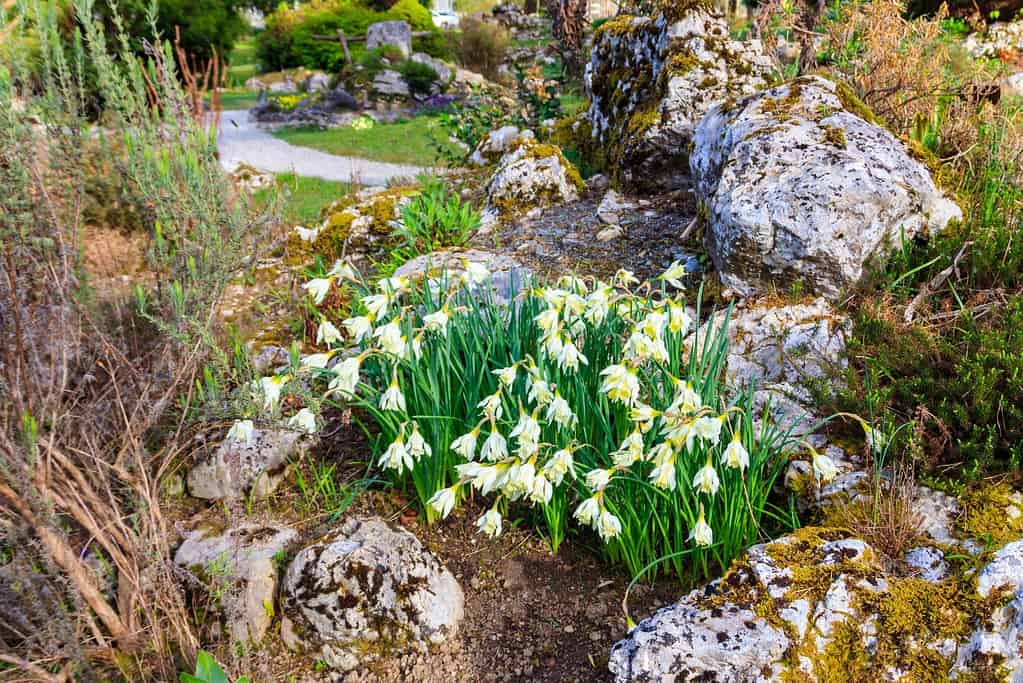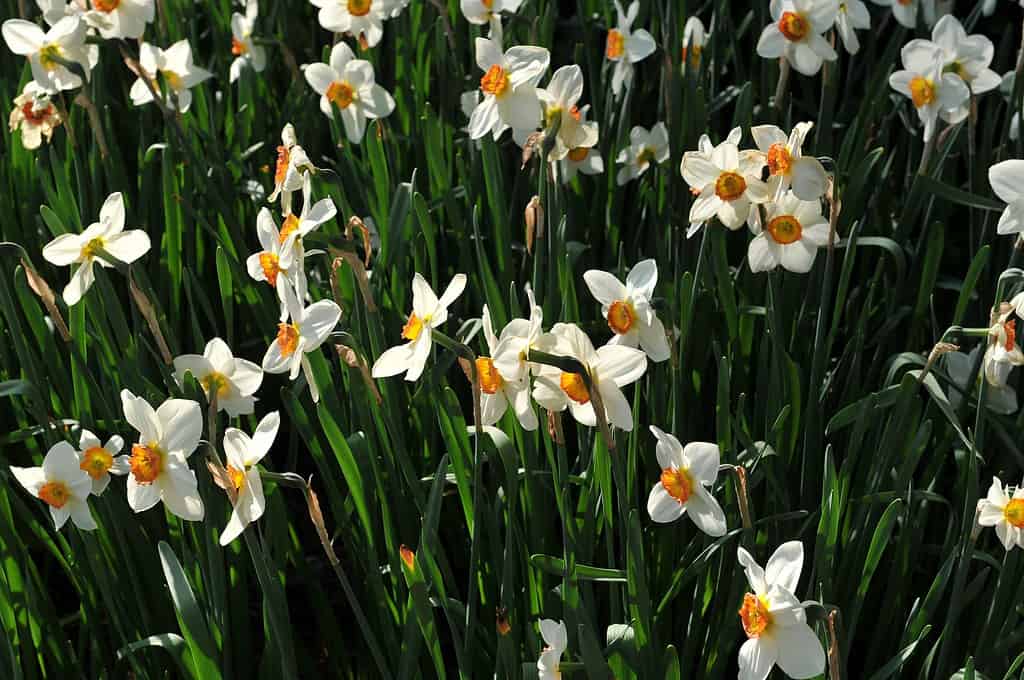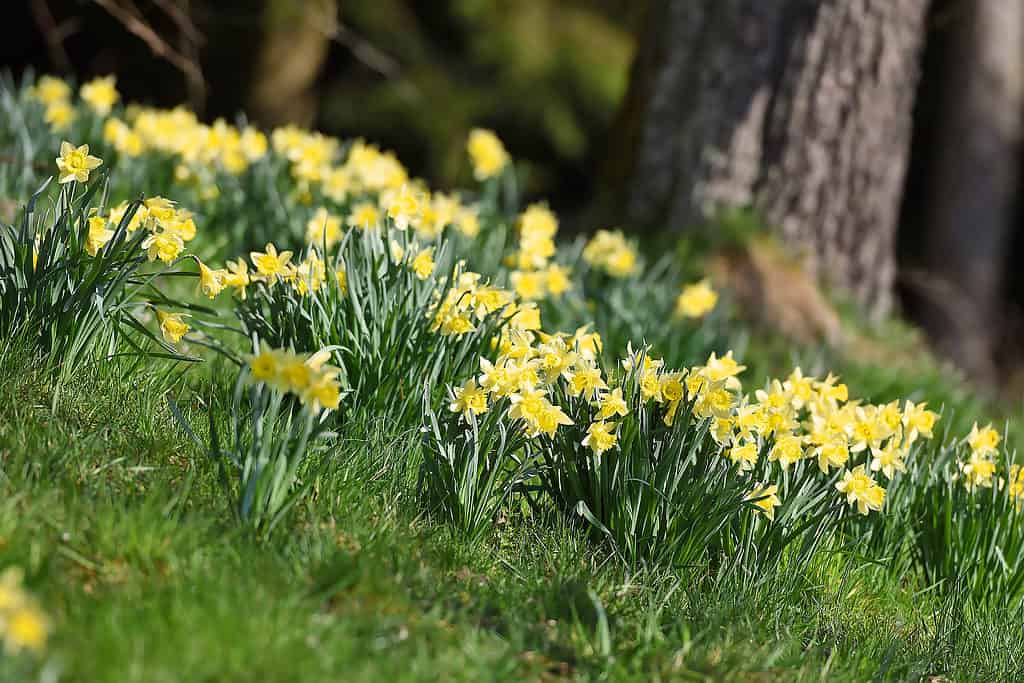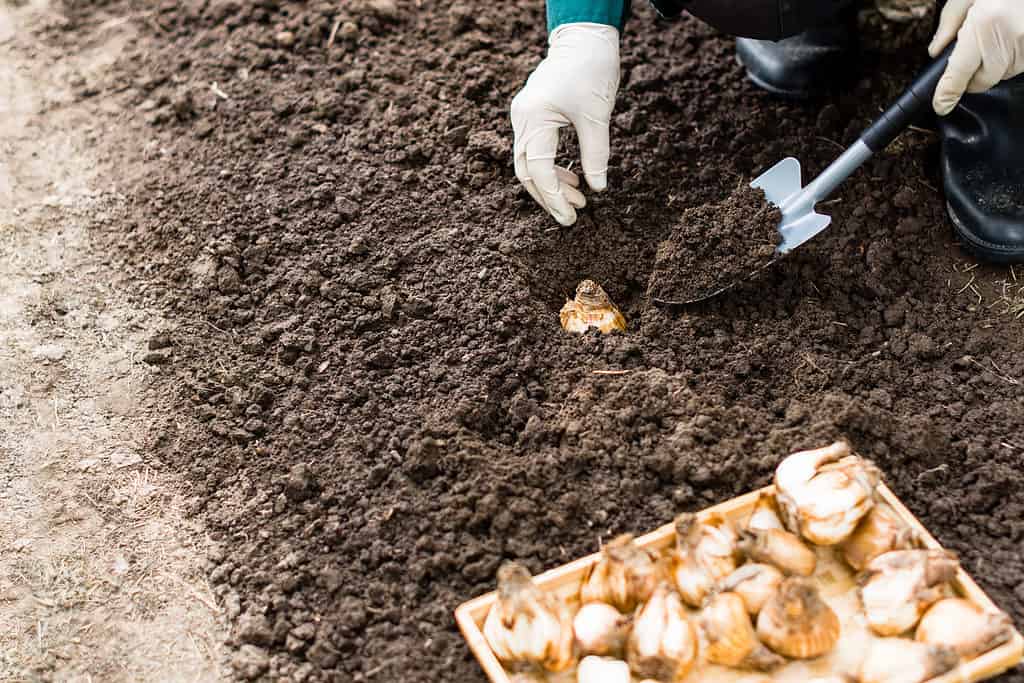Have you ever spotted daffodils growing in a field and wondered what type of wild daffodils they might be? If you found those wild daffodils somewhere in the US, they’re probably not wild at all. Or at least they didn’t start that way.
There is only one true wild daffodil, and it’s not native to North America. So nearly all of the daffodils you see growing in the wild are non-native garden plants. And those daffodils are either heirloom varieties that stood the test of time or may have been naturalized on purpose.
What’s the difference between these types of wild daffodils, and why does it matter? First, knowing which plant is actually classified as wild is important for daffodil identification. And second, you might want to learn how to grow garden daffodils in the wild once you know how easy it is to do.
So keep scrolling to discover the one real wild daffodil. Plus, we’ll look closer at three types of daffodils growing in the wild that had help getting there.

The only true wild daffodil is the
Narcissus pseudonarcissus, which has pale petals and dark yellow cups.
©Olha Solodenko/Shutterstock.com
Narcissus pseudonarcissus (Wild Daffodil)
- Common Names: Wild Daffodil, Lent Lily, Lent Rose, Bell Rose, Common Daffodil
- Hardiness Zones: 5-9
- Mature Size: Standard (12-26 inches)
- Season in Bloom: Early to Mid-Spring
- Daffodil Division: #13, Daffodils distinguished only by Botanical Name
- Flower Colors: Pale yellow petals with dark yellow cups
The Narcissus pseudonarcissus is probably the only genuinely wild daffodil you’ll find growing in nature. So when a daffodil expert talks about wild daffodils, this is likely the plant they are referencing.
The wild daffodil is native to Europe and Africa. It has pale yellow petals, dark yellow cups, and looks like a trumpet or large-cupped daffodil. However, the Royal Horticultural Society (RHS) classifies this plant as a division #13 daffodil, distinguished only by botanical name.
N. pseudonarcissus grows to a standard size between 1-2 feet high and can be grown as a perennial in Zones 5-9. Does that mean you can plant your own wild daffodils? It sure does! Look for wild daffodil or Lent lily bulbs from your favorite bulb supplier.

All wild daffodils growing in the US are non-native plants but are not currently invasive.
©Olga Miltsova/Shutterstock.com
Non-Native Wild Daffodils and How They Got Here
The earliest daffodils came from Africa and countries of the Mediterranean. You can thank the Romans for introducing daffodils to Europe and the colonists for bringing them to the States. Thankfully those first daffodils thrived in US soil, but there isn’t a single daffodil that got its start in North America.
Every wild daffodil growing in the US is a non-native species. And according to PennState Extension, daffodils didn’t become a popular ornamental plant in the US until the late 1800s.
Can daffodils become invasive?
If every daffodil in the US is a non-native plant, are daffodils invasive? Fortunately, no. Even though daffodils are easy to naturalize, most wild daffodils growing in the US are spread across areas where native species have already been disturbed. Examples of these areas include farmland, abandoned acreages, rocky landscapes, and meadows near homesteads.
Plus, daffodils don’t spread rapidly enough to result in invasive growth.
As long as they aren’t displacing native plants, daffodils can grow as wild as they please. And the ones that have been growing wild the longest are heirloom varieties.

Many heirloom daffodils are hardy cultivars that could thrive as wild plants.
©Sergey V Kalyakin/Shutterstock.com
Heirloom Daffodils In Nature
If you find wild daffodils that aren’t N. pseudonarcissus, they might still be heirloom bulbs. Heirloom daffodils are very hardy cultivars that come back year after year in their ideal climate.
For example, the ‘Firebrand’ small-cupped cultivar is an heirloom daffodil introduced in the late 1800s and still grown by gardeners today. Though it’s also a rare type of daffodil that is sometimes hard to locate in the US, ‘Firebrand’ is hardy enough to survive growing wild.
So if somebody tossed some hardy ‘Firebrand’ bulbs across a field 10 or more years ago, they might still be blooming every spring today.
How did these heirloom daffodils end up growing outside of garden beds and containers? At some point, they either naturalized on their own or got help from somebody who planted them there.

Many wild daffodils are plants that were naturalized because people grew them outside their gardens.
©Spitzi-Foto/Shutterstock.com
Naturalized Daffodils: Wild On Purpose
Daffodils grow beautifully as wild plants because they are self-propagating (multiply easily) and quick to naturalize. A naturalized plant is one that adapts well to non-native areas.
Over the years that daffodils became popular spring flowers in the US, people learned that the plants could thrive without much care and maintenance. So they grew daffodil bulbs in the backyard, across nearby fields, and in other wildly growing landscapes. These naturalized plants became what we like to think of as wild-on-purpose daffodils.
Naturalizing daffodils has been a common practice among daffodil enthusiasts across the country for hundreds of years. If you’re curious about how to grow daffodils in the wild by naturalizing them, keep scrolling for more details.

Turn garden daffodils into wild daffodils by naturalizing them.
©Jurga Jot/Shutterstock.com
How to Naturalize Daffodils From Bulbs
Do you want to grow daffodils outside of your garden beds? Naturalize them! Daffodil naturalization is easy as long as a few essential conditions are met first.
- Daffodils naturalize best in semi-loose soil (not compacted) with good drainage, like near trees, on a hillside, or in rocky areas.
- If you’re naturalizing daffodils close to home, make sure you plant the bulbs in an area that doesn’t need mowing in spring.
- Choose vigorous perennial daffodils, like heirloom plants, that are hardy in the local growing Zones.
You can naturalize daffodils from seed, but it takes around 5 years for those plants to bloom. So grow daffodils from bulbs if you hope the plants will bloom by spring.
Here are some quick steps for naturalizing daffodils:
- Plant daffodil bulbs in an area with plenty of sun during the spring. This could include planting them around deciduous trees since many of these trees don’t fill up with leaves again until late spring.
- Give the daffodil bulbs plenty of space to grow by keeping them at least 4-6 inches apart. And consider planting them in drifts for maximum color and beauty.
- Plant daffodils in the fall at least 2 weeks before the first frost.
- Try to plant bulbs 6-8 inches below the soil’s surface, with the pointed end of each bulb facing up.
- Give each newly planted bulb a big drink of water and water regularly until the first frost, if possible. You can begin watering the plants again in the spring.
- Be aware that daffodils are toxic to humans and animals. So grow daffodils in an area where your pets and livestock don’t roam or graze.
It’s also possible to scatter daffodil bulbs across the ground and then cover them with extra soil. That’s how easy-going naturalized daffodils tend to be!

Though US daffodils are non-native, these plants adapt well to wild landscapes in the right conditions.
©Alex Manders/Shutterstock.com
Wild Daffodils All Came From Somewhere Else
The types of wild daffodils you see in North America are non-native plants and mostly garden varieties. Even the one true wild daffodil plant (N. pseudonarcissus) came across the ocean with the colonists. Yet daffodils are growing wild nationwide because hardy heirloom varieties and vigorous hybrids have naturalized in non-indigenous areas.
So the next time you see some wild daffodils, take a photo. You can identify the plant and its growth habits through various apps and guides. Then you’ll know why those daffodils survive locally in the wild, even though their ancestors came from somewhere else, far, far away.
The photo featured at the top of this post is © tonkid/Shutterstock.com
Thank you for reading! Have some feedback for us? Contact the AZ Animals editorial team.






